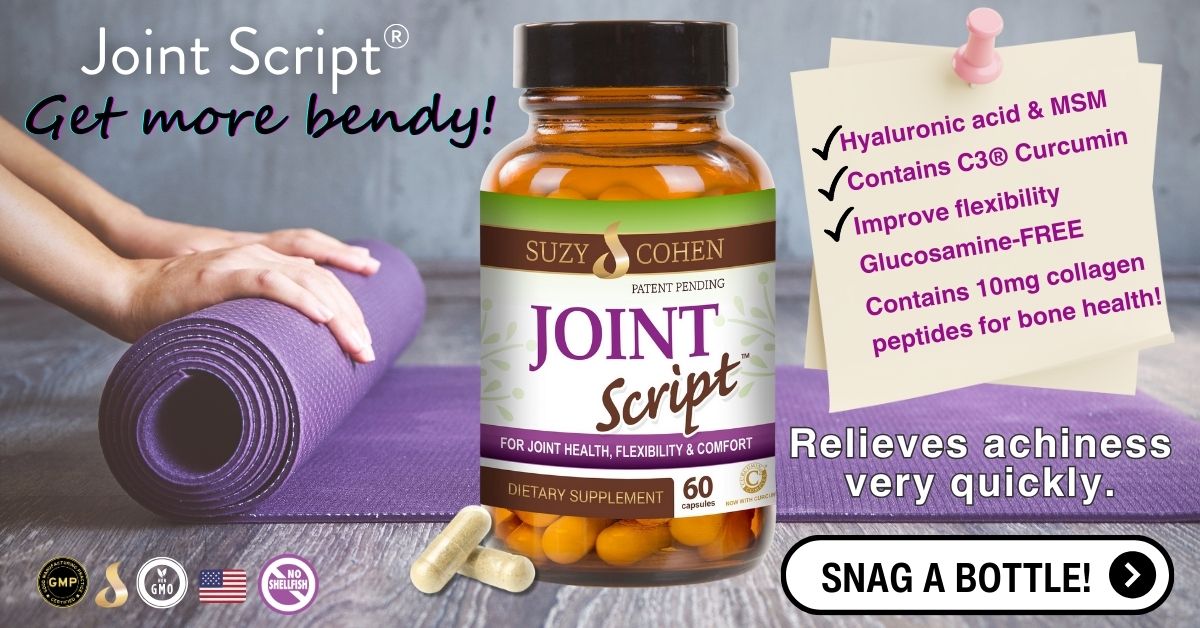As fear of coronavirus COVID-19 spreads across the United States, many people have started buying hand sanitizer. But this product is already sold out in a lot of stores and the prices online have skyrocketed due to sellers acting very opportunistically. It’s a supply and demand issue and now that everyone wants it, they can take advantage of you.
Today, I’m offering you alternative methods to sanitize your hands and cell phone cases, door knobs, buggy handles, and whatnot. I have a longer version of this article that I can email to you if you sign up for my free newsletter at suzycohen.com.
I want to make sure that you realize that hand sanitizers do not kill COVID-19. But they can be very effective at cleansing many other germs. Nothing I say here is to be misconstrued as medical advice to kill or prevent coronavirus, or any other bug like the common cold, or flu… so please do not delay seeking medical attention if you have respiratory symptoms. If you’d like to read my article about the coronavirus, CLICK HERE to read, The Flu vs. Coronavirus: A Potential Health Emergency.
Use of hand sanitizers is an excellent way of minimizing your own exposure to someone else’s germs, for example a door knob, or the faucet handles in a public restroom. You can periodically spray your own hands, or your steering wheel and gear shift.
Below are the best ‘recipes’ to sanitize your hands when soap and water are unavailable. Put these into a little spray bottle and carry with you. I invite you to experiment like I do. By that I mean, if you find that one of my recipes is too drying for your hands, then add a softener or “emollient” to it such as a tablespoon of aloe vera gel or drinkable juice (I’ve used both on my skin), or a teaspoon of grape seed or olive oil, or glycerin. You can buy glycerin online, or at any pharmacy, and sometimes in the candle-making section of craft stores. Some of you have glycerin suppositories which you could warm up and use. Keep in mind glycerin is water-soluble so it will mix well with a liquid solution, whereas mineral oil does not. If you opt for mineral oil, you will have to shake your solution just like you would a salad dressing, but it will work to soften. These are not necessary, they’re optional additives. If you think about it, regular, normal hand sanitizer is usually drying and no one really cares, so again, these emollient ideas are totally optional.
Don’t add too much of an emollient because you will increase the viscosity of your solution so much, that it may fail to spray out of the tiny orifice of your spray bottle! You can add a little bit at a time, and continue checking the sprayer to see if it comes out. Remember, these are just for softness, not for medicinal action. By the way, while we’re talking about softening your skin and hands, you may be interested in reading my other article which will give you recipes to make your own moisturizers, Luxurious Body Creams that Won’t Cause Cancer.
Nevertheless, I want you to feel free to experiment like this, and even try incorporating different essential oils (EO) that you like. Remember, EOs are plant-derived constituents that come with a broad spectrum of killing activity, some of them target the flu. The ones I’ve listed below have documented anti-viral, anti-bacterial and anti-fungal benefits to humans, either as external application or through vapor (think of a steam inhalation). You can read more about essential oils in my article, My Favorite Winter Essential Oils.
I’m about to give you some ideas for creating your own hand-sanitizer. Caution: Do not spray any of these on your face, or near your eyes because it will burn. These are intended as recipes for external application only.
Here are some of my best ideas to make a home-made hand sanitizer:
Hydrogen Peroxide.
You can buy 3% hydrogen peroxide pretty much anywhere still. Put this in a spray bottle and use it like you would hand sanitizer. If you want to make it last longer, dilute it with a little water.
Tea Tree Essential Oil.
Combine 10 drops of essential oil of tea tree and mix with approximately 4 ounces of water and put into a spray bottle. If the scent is too ‘antiseptic’ for you, you can certainly add some other essential oil that you like such as lemon or lavender, both of which offer even more anti-bacterial and anti-viral benefits.
Eucalyptus in Aloe Vera.
Pour out 1 ounce of aloe vera gel or juice into a 4 ounce spray bottle. You can use either in my opinion, and I’ve done that myself. The aloe juice is technically drinkable, but the reason it might be okay for your spray bottle is because it is less viscous, so it goes into solution very nicely. I’ve made my own home made facial toners using aloe vera juice (not gel). The gel is fine too, it’s just thicker and it’s sold for external use. Either way, the next thing you do is add 10 drops of essential oil of eucalyptus and finally, fill the bottle to the top with water. This on its own is a strong hand-sanitizer, however you can add other EOs if you’d like to. Thyme would be my choice, it has very strong anti-bug activity!
Distilled White Vinegar.
Many of you have bottles of plain vinegar in your home to use as a cleanser, or in recipes. You can buy about a gallon of this stuff for 5 dollars or so! Vinegar is a great disinfectant and is known to destroy many gram-negative bacteria like E. coli, Salmonella and other pathogens. You can use this all by itself, or add any EO to it that you like. If I were making this, I would add 5 drops each of patchouli, lemongrass, tea tree and thyme. That’s a total of 20 drops for your 4 ounce spray bottle. Feel free to experiment with other oils that I’ve included in my article today.
OnGuard® by Doterra or Thieves® by Young Living.
These two essential oil blends are popular among EO junkies so some of you reading this probably have either OnGuard or Thieves in your home. If you do, take about 10 to 15 drops of this and put it into your spray bottle with water. For those of you who do not have either of these proprietary blends, you can mock it up yourself. The essential oils in these are as follows: clove, cinnamon, eucalyptus, rosemary and this is where they differ…. one has lemon (Thieves) and the other has wild orange (doTerra). If you’re making this yourself, my suggestion is to use 5 drops of each EO per 4 ounce spray bottle.
Rubbing Alcohol.
If the stores run out of everything, you can always use rubbing alcohol to kill germs. Most people have an old bottle of this somewhere in their medicine cabinet. I recommend you dilute by about 50 percent with some water. It’s still going to have a very strong alcohol scent to it and it will be very drying. You can add one of my suggested emollients to the spray bottle. If the scent is too much, add some thyme, eucalyptus, lemon or orange. These are all very strong EOs that will mask the alcohol and add a layer of anti-everything to your sanitizer!
Colloidal Silver.
We all know that silver was the antibiotic of choice for years until proprietary drugs became available. Silver is a strong antibacterial. You can buy a bottle of colloidal silver and use it at 100% strength in your spray bottle. Don’t dilute it. I’d personally recommend that you add 5 drops each of clove and eucalyptus to the silver. Optionally, you can add some EO of bergamot, lemon, basil or rosemary to the mix. These not only add fragrance, but also more protection.
Boswellia and Bergamot.
You can make what’s called a decoction, it’s simple! This is the term used to boil an herb (plant material) to dissolve the special components in water. In this case, you will use bulk Boswellia serrata herb (buy online or at a health food store), and simmer it for 15 minutes in water. Strain it and cool it. Take your 4 ounce spray bottle and fill it almost to the top with the boswellia (frankincense) water. Add 10 drops of bergamot essential oil. If it has too much zing from the bergamot which is very citrusy, then add 10 drops of lavender essential oil to calm it down.
Turmeric.
There is an essential oil of turmeric that you can buy now, but it costs a lot. If you have this, add 10 drops to a 4 ounce sprayer along with 10 drops of cinnamon and 10 drops of grapefruit. It’s going to smell weird but it covers a broad spectrum of bugs.
The one ingredient that you’ve probably heard of is called curcumin and it comes from turmeric spice. It’s a curcuminoid. You’ve heard me use that word before when I’ve talked about Joint Script which contains a special blend of curcuminoids (all 3 of them!). Anyway, it’s the turmeric root that gives us the curcuminoids which have strong anti-inflammation and antibacterial activity.*
So please don’t worry if you don’t have the essential oil. Simply buy the actual root of turmeric at a grocery store. It looks similar to fresh ginger, and turmeric root is almost always right next to the ginger in the produce department. Cut and peel an inch of turmeric and simmer in approximately 6 to 8 ounces of water. Strain and cool. This ‘turmeric water’ can be added to any blend above, or you could use it on its own in a 4 ounce sprayer.
If you have distilled water to use for this project, it would be ideal, but if all you have is regular water that is totally okay. It’s not that big of a deal. Also, if you have any other ideas for a home made hand sanitizer (or your own effective recipe) please email me at ScriptEssentials@gmail.com and I will post some of your blends and ideas for others to benefit. Thanks for taking the time and please forward to a friend.
Before closing, I’d like to mention that Selenium is an absolutely remarkable mineral with properties that support immune function.* It is usually not discussed in those terms because people think of selenium for breast and prostate, or thyroid function. So if you have a few minutes, please let me enlighten you to Selenium. CLICK HERE to read, 6 Mind-Blowing Reasons You Should Take Selenium.
CLICK LIKE to FOLLOW Suzy Cohen – Get Important Health Tips

Suzy Cohen, has been a licensed pharmacist for over 30 years and believes the best approach to chronic illness is a combination of natural medicine and conventional. She founded her own dietary supplement company specializing in custom-formulas, some of which have patents. With a special focus on functional medicine, thyroid health and drug nutrient depletion, Suzy is the author of several related books including Thyroid Healthy, Drug Muggers, Diabetes Without Drugs, and a nationally syndicated column.


